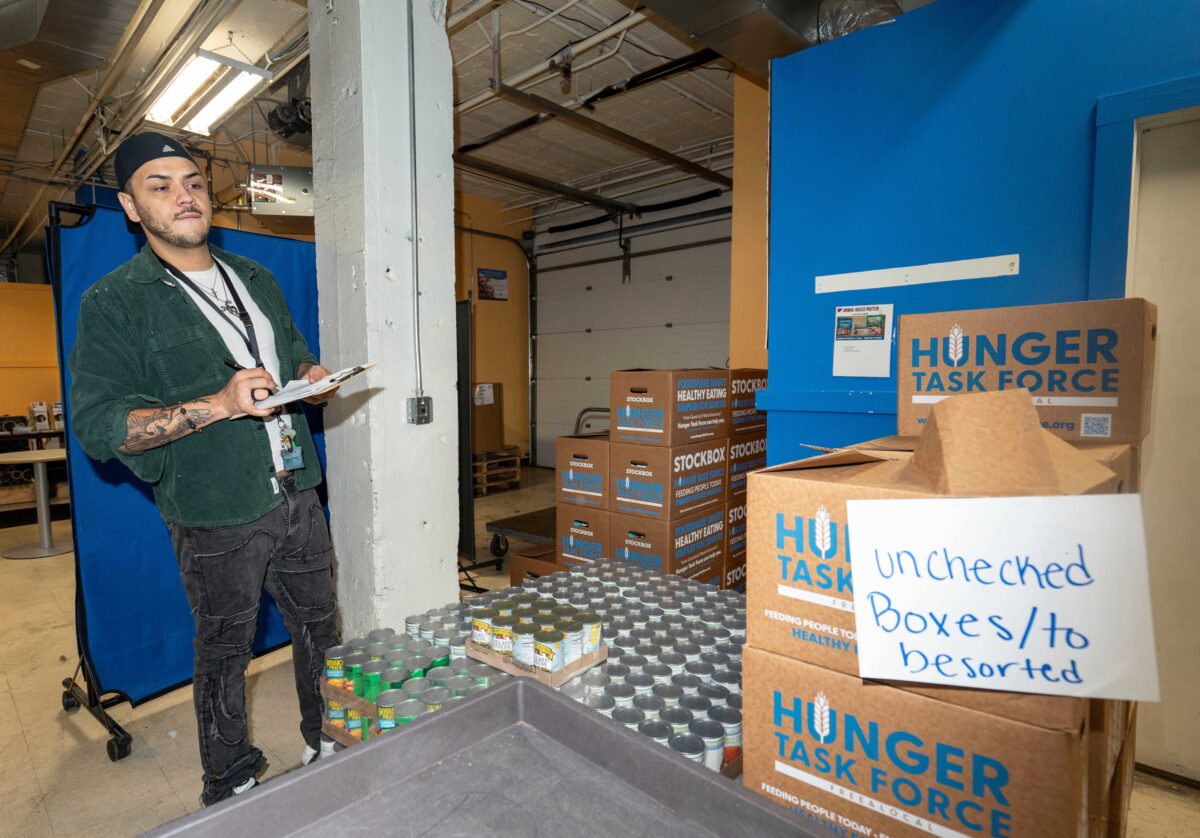
Julio Bravo, a food pantry associate, takes inventory of items in the Emergency Food Pantry at the Milwaukee Community Crossroads on Friday October 3, 2025 in Milwaukee, Wisconsin. (USA Today via Reuters Connect)
When Andrea Grittner joined Milwaukee Community Crossroads in 2022, the organization’s food pantry served just over 2,000 people that year.
In 2024, that number more than tripled to over 7,000 residents, said Grittner, Community Crossroads’ director of development and communications. Demand this year is expected to exceed that.
Some of the rapid rise can be attributed to Community Crossroads’ efforts to serve residents beyond the south side of Milwaukee, where it’s headquartered, Grittner said. Community Crossroads was founded in 1921 as Milwaukee Christian Center and provides housing, elder services and youth development programs in addition to food assistance.
But it’s mostly driven by rising grocery prices and federal program cuts that have left more residents struggling to afford food, Grittner said.
“We know it’s not just us,” Grittner said. “We know pantries across the country, quite frankly, that are dealing with the same thing.”
Community Crossroads is a partner with Hunger Task Force and Feeding America Eastern Wisconsin, the largest food distribution nonprofit in the state with a network of around 350 food pantries, shelters and meal programs.
Feeding America Eastern Wisconsin reported a network-wide increase in demand of around 30% since 2022, according to director of partnerships Abby Beau.
“We’re seeing a lot of partners that are drastically noting increases of unduplicated individuals that are patronizing pantries, meal programs, shelters, etc.,” Beau said. “We haven’t seen any sort of suggestion that that would be going down or is trending downward in the near future.”
Feeding America and other food bank services have had to take on a bigger role in addressing the growing need for food assistance, shouldering more of the costs that previously would have been covered by government programs, Beau said.
Feeding America estimated that 697,000 Wisconsin residents, or 11.8% of the population, experienced food insecurity in 2023, the most recent year available. In Milwaukee County, nearly 15% of residents struggled to consistently access enough food.
Food insecurity occurs when a household cannot consistently afford enough food and is related to factors such as income, access to affordable health care and the availability of affordable groceries in the area.
Feeding America Eastern Wisconsin distributed 38.3 million pounds of food in 2024, up 12% from 2023, according to the nonprofit’s annual report.
“Since 2022, we’ve seen hunger increasing across Milwaukee and the state as a whole,” Beau said.
Rising grocery prices drive demand for food pantries
Beau said a significant driver of increased demand for food pantry services is the rising price of groceries.
Grocery prices rose 0.6% nationwide between July and August and 29% since before the COVID-19 pandemic, according to data from the U.S. Bureau of Labor Statistics.
Inflation also hits people with disabilities, part-time workers and those who are unemployed — groups at greater risk of food insecurity — particularly hard, said Brian Jacobsen, chief economist at Annex Wealth Management. Without wages that can keep pace with rising costs, the gap between their income and grocery bill continues to grow.
“People are stuck and sort of getting kicked while they’re down in terms of trying to access to healthy, nutritious food on a consistent and regular basis,” Beau said.
Unemployment has also ticked up since last summer, though Wisconsin remains below the national 4.3% unemployment rate. The Milwaukee-Waukesha metropolitan statistical area reported a 3.7% unemployment rate in August, up from 3.4% in August 2024, according to data from the Department of Workforce Development.
Manufacturing has been declining nationally for the past few years, Jacobsen said, which hurts the manufacturing-heavy southeast region more than other parts of the state.
“There is a divide where it does seem like southeastern Wisconsin — Milwaukee and Racine in particular — has seen some declines,” he said.
SNAP restrictions put more strain on residents
The federal budget bill signed by President Donald Trump this summer removed work requirement exemptions for many recipients of the Supplemental Nutrition Assistance Program, or SNAP.
Starting Nov. 1, adults with children ages 14 to 17 and U.S. military veterans must prove they work or volunteer at least 20 hours per week in order to qualify for food assistance under SNAP.
The program, called FoodShare in Wisconsin, serves around 700,000 Wisconsin residents, according to the state Department of Health Services.
New work requirements add another hurdle for federal food assistance recipients after the end of pandemic-era emergency SNAP allotments in 2023, Beau said.
“It’s this multifaceted idea that people are struggling to make ends meet,” Beau said. “Families are facing hunger on a daily basis, and you’re taking away access to benefits that were providing coverage in previous ways that they are no longer providing.”
And since SNAP benefits adjust for inflation only once per year, high month-to-month inflation can eat into people’s short-term purchasing power.
“Even if you are receiving those benefits, if it’s staying stagnant, if food prices continue to rise you’re able to buy less food,” Grittner said.
Tariffs, extreme weather could keep food prices high
Though the inflation rate has declined from its peak in 2022, the outlook still looks mixed.
While inflation on services has slowed, inflation on goods, which includes food, is accelerating, Jacobsen said.
Part of that is due to tariffs on imported foods like coffee and bananas. Importers have already passed much of the tariff costs onto consumers through price hikes, Jacobsen said.
Extreme weather events have also hurt crop yields across the globe, while an avian flu outbreak in the U.S. caused egg prices to soar in 2023 and 2024, Jacobsen added.
Recent changes in U.S. tariff and interest rate policy also create a level of uncertainty in the economy, according to Bret Mayborne, vice president of economic research at the Metropolitan Milwaukee Association of Commerce.
“The uncertainty we’ve seen economically in the last three, four, five months is an area of concern,” Mayborne said.
There are some future bright spots for the southeast Wisconsin labor market, Jacobsen said. A wave of companies recently moved their headquarters to Milwaukee, signaling a willingness to invest in the region. Other large projects, including Microsoft’s $7.3 billion investment in Racine County data centers, are expected to create thousands of construction jobs.
But until these investments translate to local jobs, more residents could still struggle to afford food.
“Unless labor market conditions improve, which I think they will as the year goes on, food insecurity could get worse before it gets better,” Jacobsen said.
Milwaukee Community Crossroads is prepared for need to keep rising in 2026, Grittner said. In addition to food pantry services, which the organization sets up under a grocery store-like model, it also provides free diapers and hygiene products.
Community Crossroads takes food, baby product and hygiene product donations. Residents can also make monetary donations on its website.
“Really, we just try to find the gaps, try to not duplicate services, and really meet the needs that aren’t being met,” Grittner said. “We’re ready to weather whatever is coming in the next few years.”
How to donate to Stock the Shelves
Each October, USA TODAY NETWORK-Wisconsin newsrooms partner with Feeding America Eastern Wisconsin to raise money to support the food banks. This year’s goal is to raise enough money for 550,000 meals.
To donate online, visit FeedingAmericaWI.org/StockTheShelves
To donate by mail, checks made payable to Feeding American Eastern Wisconsin, ATTN: Stock the Shelves, should be sent to 1700 W. Fond du Lac Avenue, Milwaukee, WI 53205.
Enclose with your contribution the donor’s address with city, state and ZIP code for internal processing, a notation of whether the donation should remain anonymous, and/or whether the donation is in the memory of someone special. Also list the donor’s name as it should appear in a thank-you advertisement to be published in the Thanksgiving editions of USA TODAY NETWORK-Wisconsin’s daily newspapers.
For a map of food pantries, meal programs, and shelters supported by Feeding America Eastern Wisconsin, visit FeedingAmericaWI.org/Find-A-Pantry.
This article originally appeared on Milwaukee Journal Sentinel: Food pantry demand up sharply. Here are the factors that contribute to the increased need.
Reporting by Francesca Pica, Milwaukee Journal Sentinel / Milwaukee Journal Sentinel
USA TODAY Network via Reuters Connect

8 ordinary Wisconsinites who performed extraordinary acts of kindness in 2025
These eight Wisconsinites went above and beyond to spread kindness in their communities this year. Sometimes it can seem like the world is full of...

‘Sleep Out’ event provides shelter and education on homelessness
Tyrone Baldwin is homeless and was in his tent on Milwaukee’s north side in early 2025 when a wet, heavy snow caused his tent poles to break. The...

Waupaca man’s pumpkin carving hobby has been delighting residents of all ages for over 25 years
WAUPACA, Wisconsin ‒ It started 25 years ago with five carved lighted pumpkins displayed in front of Jim and Deb Miller’s rural Waupaca home. Over...

Do you know a farm MacGyver? Or a Dairyland Darling? Wisconsin farmers redefine stereotypes
Even if you haven't met these Wisconsin dairy farmers in person, you know someone just like them: the farmer that keeps the farm running with a bit...




